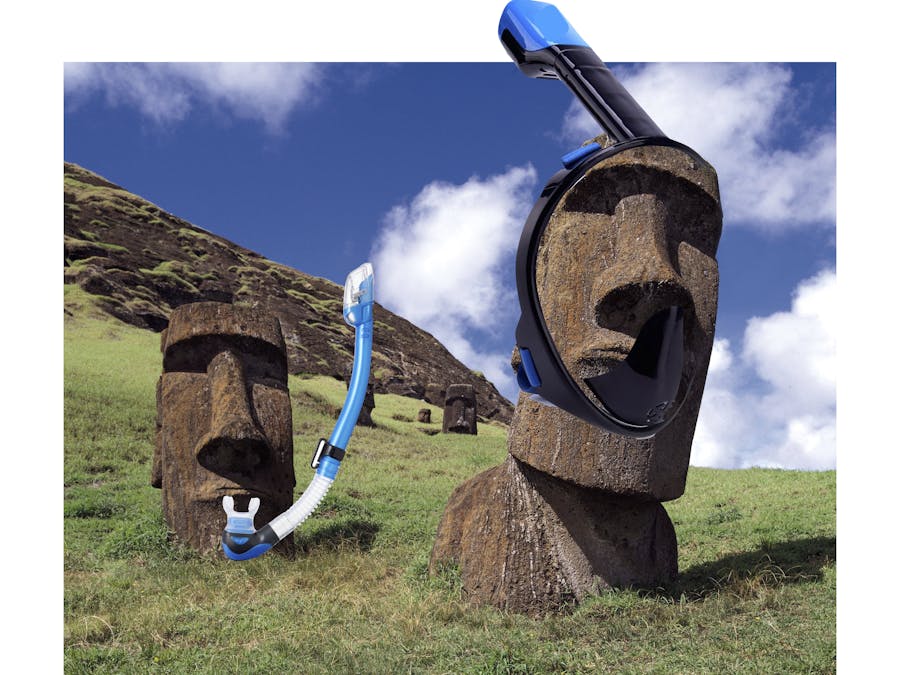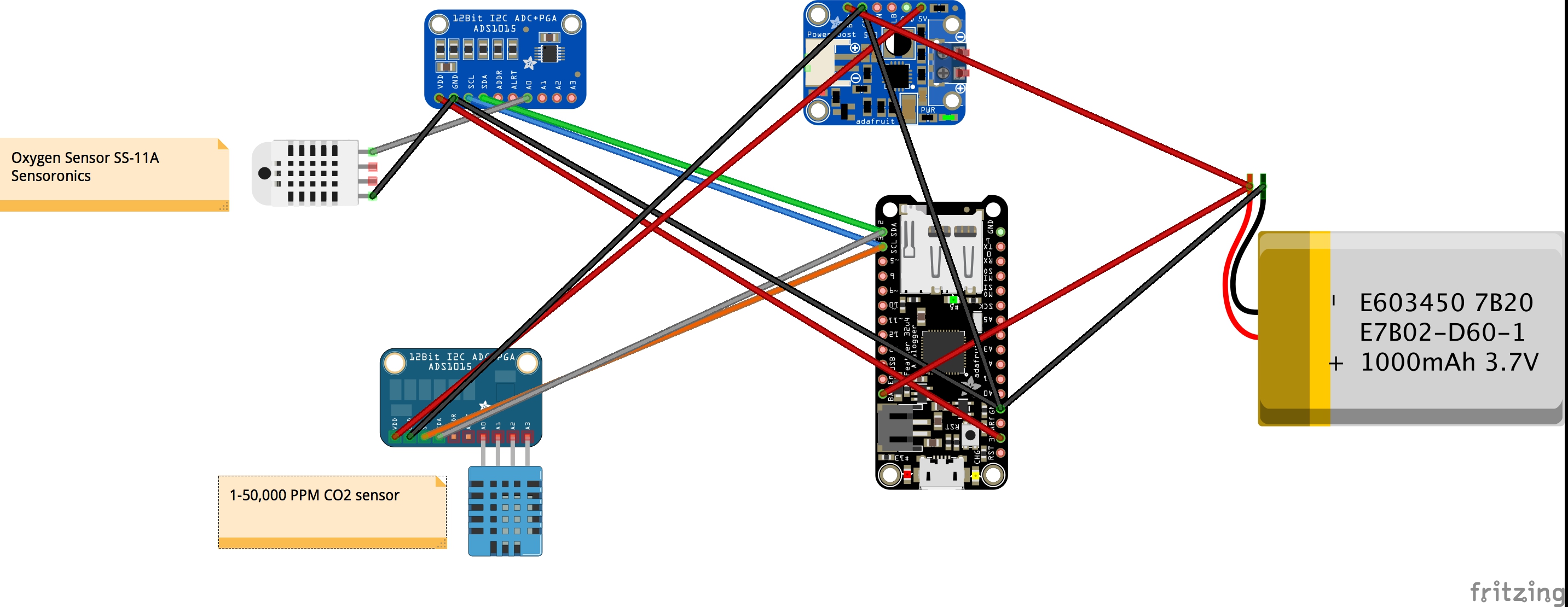By rabbitcreekFollowMore bythe author:
OSHA--Occupational Safety and Health Administration
Paragraph (d)(2)(iii) of the Respiratory Protection Standard considers any atmosphere with an oxygen level below 19.5 percent to be oxygen-deficient and immediately dangerous to life or health. At concentrations of 16 to 19.5 percent, workers engaged in any form of exertion can rapidly become symptomatic as their tissues fail to obtain the oxygen necessary to function properly.
So that is a rather sobering statement. It suggests if you have to work in an environment like that you need a mask! Well what if the mask you put on your face is causing the oxygen level to drop... well lucky we're not working--just snorkeling so these rules don't apply. My last tutorial: https://www.instructables.com/id/CO2-Measurement-... detailed the CO2 complications in snorkels so I was curious if the CO2 was compromising the oxygen levels as I alluded to. To find out how to read O2 levels I just went to Instructables web site and found this great writeup on how to do it: https://www.instructables.com/id/Easy-To-Build-Ox...
Again I am putting in a disclaimer because of the series of deaths that have recently occurred with snorkeling here on Maui. I am not a health expert of any sort with no degrees in anything that would help sort out why people may have health issues while snorkeling. I am just a tinkerer that likes to build things.
Step 1: Gather Your MaterialsI piggy backed the Oxygen sensor circuit onto the same data handling computer that I used for the CO2 snorkel experiments so that I could record both levels at the same time through a I2C connection that had different addresses. The Oxygen sensor is a small fuel cell type device that uses oxygen in generating a level of electricity (mv range). Voltage is linear to level of Oxygen and you just have to amplify and digitalize the information to make it useful. The remainder of the electronics were the same as the CO2 sensor.
1. Adafruit ads1015 breakout board https://www.adafruit.com/product/1083
2. SS-11A Replaces: Teledyne R17 & MSA 406931https://www.sensoronics.com/collections/medical-oxygen- sensors
3. Adafruit Feather 32u4 Adalogger--A wonderful board very easy to use.
4. Lithium Ion Polymer Battery - 3.7v 1200mAh
5. PowerBoost 1000 Basic - 5V USB Boost @ 1000mA from 1.8V+
6. http://sandboxelectronics.com/?product=50000ppm-m...
7. A bunch of full face and regular snorkels
Step 2: Wire ItThe wiring is pretty simple--just leave it in dead bug format so that you can get the components separated to fit better in the various snorkel holes. Follow the Fritzing diagram--sorry the CO2 and Oxygen sensors did not have graphics that I could use in this format so I just used a generic air sensor in each case. Both sensor boards connect to the same SCL and SDA lines. The Oxygen sensor is connected with a common speaker wire plug in its top--just cut off the plug on the other end and strip the very fine wires and measure polarity and connect the positive to the first amplifier circuit and ground to the other. These sensors are fairly delicate, have a limited lifetime and change baseline voltage and must be calibrated for each use. The plus side is they are fast and very accurate--the same ones that are used in anesthesia machines that you trust your life to. Test yours before you wire it up with a voltmeter just to make sure it didn't come DOA. Use a ton of hot glue on all your connections as the various tortures of snorkel yodeling will fry them if you don't.
Step 3: Build ItThe conventional snorkel was modified with a short flexible hose addition. The final length of the snorkel was trimmed to reflect the original volume. The Oxygen sensor was mounted tangentially through the sidewall which included the CO2 sensor. Both sensors were mounted at the very base of the snorkel where the air exchange takes place. All wires and the computer were mounted external to the snorkel tube with zip ties.
The full-face snorkels were tested individually by placing all the components inside of the mask. Where the Serial port was used for connecting to Processing for output the wire was guided through the rim of the mask without interrupting its seal. The two sensors were mounted close to the air exchange valves in the main chamber of the mask. While some volume depletion of the mask by the components was possible it probably was not very significant.
Purge valves located both in the conventional snorkel and the full face snorkel were closed over with duct tape for all experiments. My multiple videos with both snorkels in the pool never revealed any air exhausting under normal circumstances from these ports. I went to the trouble of measuring the opening pressure of these ports underwater and found (obviously) that it was equal to water depth--and tough to open with normal breathing....
Step 4: Program ItThe first Arduino program CO2_O2 filer sets up the Adalogger to take values from the CO2 sensor and the O2 sensor about once a second and record them to a SD card. A new file is set up every time the Arduino is reset. They are sequentially numbered up to 100 and then you have to reset the card. The CO2 sensor works just the same as before. The O2 sensor has to be calibrated every time you reset the computer. Twenty baseline readings are done and the average is taken in room air and matched to a value of 20.9%. Subsequent measurements of O2 percentage are 20 reading averages of the sensor divided by the calibration multiplied by 20.9 to give the % oxygen in the snorkel. This value is saved every second along with the CO2 measurement.
The second and third programs are adapted from: https://github.com/BillKujawa/meter
It is a great program written for Processing and Arduino that displays an infinitly adaptable analog meter for displaying the data on a screen as it is pumping out of the snorkel. The original program is designed to utilize a mapping statement for 1-255. In the program the % O2 is multiplied by 100 to give an adequate range of values on the meter face.
Step 5: Snorkel DesignA snorkel is a tube--so much for conventional snorkel design.
Full-face snorkels are more complicated. In my last tutorials I built mock-ups of full face snorkel assuming a even mixture of gasses in a bowl like configuration. The details in their design are more complicated but most end up acting like this. There are a variety of designs now currently on the market. I bought four of them for testing and while this is not a review I will go over several design details. The basic flow pattern is drawn in the first frame above. All Full-Face snorkel have an air input channel in the tube above and a inner mouth-nose flexible surround with one way valves in. Output is designed to go through subtle air channels at the rim of the mask making their way to the two outside channels in the upper snorkel tube. In one mask this side channel led to two valved escape ports at water level near the rim of the mask and the upper tube was for incoming air only. There was variations in how this side channel was open to the mouth area and to the eye area above in each mask. Dead space design worries in this type of mask are situated in the inner skirt area where any openings would allow exhaled air to mix with incoming air. The exit through the rim of the mask is not protected by a one-way valve so air recently exhaled can be drawn back in which would occur prior to the one way valve opening for inhaled air. Both exhaled air and inhaled air are mixed at the snorkel head where both sets of tubes usually sit under a cap.
Step 6: ResultsThe snorkels were tried by me, my wife and a friend. We sat, we treadmilled and we biked. All of them reduce your O2 below OSHA 19.5% including the conventional snorkel whether you are moving or stationary. Of the multiple models of full-face snorkel we tried the only standout was the lone full-face snorkel with the side ports--both Oxygen and CO2 remained nearly normal during its use! Just as expected CO2 and Oxygen concentration mirrored each other in almost all studies. We wore O2 sat meters during the treadmill and biking tests...and my O2 sat did fall to 90% with exercise which stopped the test. Depending on the person/face the O2% levels in the full face snorkels sometimes fell to 16%. The graph above for 5 min sitting with full face is one of the more benign trials. The conventional snorkel is also a worry. Oxygen levels vacillated wildly with each breath which is what you would expect from a device with a stacked dead space. The full face snorkels acted like the models in my last tutorial with large mixing dead spaces. The exit strategies for funneling exhaled vapors did not prevent the high levels of CO2 and low O2 into the upper area of the masks except in the one design.
Step 7: DiscussionAny snorkel is a strain on the respiratory system of humans which is designed to provide, within limits, adequate oxygenation to the blood. If the system detects low oxygen or high CO2 its auto-regulating system kicks up respiratory rate or depth to compensate. Snorkel breathing may not be a hazard if these adjustments can be made. That is why during all of the tests (except biking) our O2 sats remained normal--faster deeper breathing compensated for a poor oxygen supply. One concern I have is that these adjustments are normally done on land--in the water they may be harder. A great reddit thread regarding snorkel breathing: https://www.reddit.com/r/askscience/comments/3ap7.. indicated that problems with inhalation become more marked with depth--limiting out at 1/2 meter. Breathing underwater is harder because you have to expand your chest against the remarkable increases of water pressure as you go deeper. Multiple factors are at play but testing for tidal volume fluctuation on land and snorkeling would be interesting.
The good news with all of this snorkel obsession is that snorkels can be designed to enable nearly normal O2 and CO2 levels.
Step 8:





Comments